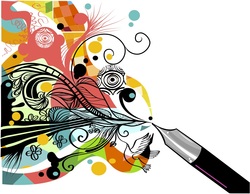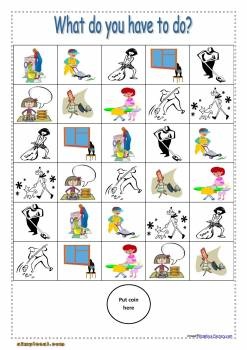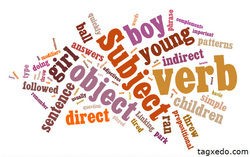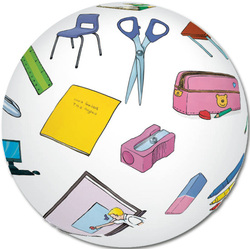
This week I decided to shift our focus from the connection between the images and the words to working simply with the written vocabulary. To begin, I had B read out each of the words I laid out. Once again, the only words he had troubles with were "crayon" and "ruler". I suspect that this may be a result of a difficulty with the letter "R".
To practice with the construction of the words, I had B complete a word scramble. This was presented as a fun game, but is intended to present the vocabulary in another way to practice writing it. What was interesting was that B did not recognize the letters in the words as a whole. He counted the number of letters present and began to count the number of letters in the words he knew. This tells me that he recognizes the word as a set of letters in one specific pattern. As soon as those letters are moved in any way, the word disappears.
For the other activity, we continued our practice with the coin flick game. He was just as enthusiastic about this as before and was quickly choosing where he would aim the coin. Once again, he copied the sentence that matched the image and read it out loud. He does have some problems with the word "have" but is able to recognize the rest. I also noticed that he is beginning to write down some of the names of objects without referring to the word slips provided.
When we return from the break, I intend to introduce a new set of words. We will complete some activities which mix the two word sets, while others will deal exclusively with the new words. A couple of games I hope to introduce is a version of "Go Fish" as well as a version of the word scramble using letter tiles from "Bananagrams".

This week we started practicing B's vocabulary words using a coin-flick board game such as the one in the photo. He would flick a coin and whichever picture it landed on would determine which sentence he had to say and write down.
The images showed the classroom objects he has already practiced along with either a checkmark or a 'x'. The checkmark means "Yes, I do have _________" while the 'x' means "No, I do not have _________." For example, if the coin landed on a pencil with a 'x', B would say "Yes, I do have a pencil." He would then have to find the corresponding words and write it down in his notebook.
B really enjoyed playing the board game. He would get excited about each shot and even started making goals for himself. He attempted to follow a "yes" "no" "yes" no" pattern in his sentences and would purposefully shoot at the words which still gave him trouble.
As before, B still has troubles with the words "crayon" and "ruler". He can identify a "textbook" and a "notebook" now, but occasionally mixes them up. He still repeats the words to himself to try and fix them in his memory. After a final review of the words next week, I plan to introduce a new word set.

To start off this week, we had a review of the words B went over the week before. He did better than before and only had difficulties with ruler, textbook, and crayon. B has demonstrated that he is not guessing as much and is making the link between the words in oral and written form.
To introduce something new this week, I decided to introduce the idea of sentences. This was something he seemed little more uncomfortable with. He says the sentences after I say them, but hardly does it other times due to an apparent lack of confidence in his understanding. The sentences were "Do you have....", "Yes, I do.", "No I don't", and "Do you have...?". We practiced saying them a few times before moving on to something new.
Studies have shown that students who are learning a new language respond well to games. I found a board game which would encourage B to practice his sentences, but he would only say them with encouragement. This may change over time and we will continue to work on his sentences.
For the second session with B, I decided to continue with what he learned the other day in order to enhance his comprehension. We again matched the words with the pictures in various ways. B showed much more confidence with the vocabulary words and was able to match most of the pictures with the proper words. The ones which still pose a problem are ruler and crayon. In addition, he understands the word book but has difficulties distinguishing between the two different kinds.
In order to practice the writing of the vocabulary words, I gave B a crossword to complete. The clues were the photos of each object. He would tell me the word and then write it into the space provided. When stuck for spelling, B would look through the words until he found the matching one and copy it down. He did this with no problems.
We rounded off the session with the addition of two more words to his vocabulary book. I gave him the choice of which words he would like to add and was pleasantly surprised when he chose to copy the two variations of book which have been giving him difficulty. He is displaying his want to do better and to enhance his own understanding of the language. To continue next week, I plan on introducing sentences which including yes/no answers, a question, and phrases worded with "I have".

Hello!
My name is Miss Gloge and I am a university student who is currently completing my final practicum in order to graduate and become a fully certified teacher. As a part of the final practicum, it is mandatory to do a professional development project. We are given the option to choose an area that is applicable to our situations and to fully research it. We then must present our findings to show our learning process.
Back in December, I briefly met the class I was to spend the next four months teaching. I was very excited and my brain was already buzzing with idea after idea. Once I found out that there was an ESL student in my class, I couldn't help but think about how I could help him develop his language skills. I have always been a language person (my major is French) and I remembered the little bit of work I had done with a couple of other ESL students in a grade five class I observed in my first year. Once the idea was set, I couldn't help but be excited about starting this project.
In order to fully understand what level he is at, it is important to know a little about his background. I questioned his teacher and the following is a brief overview of what I have gathered. (I will from hereon in refer to him as B).
B moved here from a refugee camp just this year. He did not speak a word of English and his parents knew very little. In addition, he was never given the opportunity to read or write in a school. Today, B can speak some simple English words, but no full sentences. He did some work with another student teacher in the fall with the names for farm animals and colours, but these words seem to have disappeared somewhat from disuse. He was also exposed to some phonetic work, but seemed resistant to it. He tries to mimic others and is willing to copy and learn, but becomes frustrated from time to time when he can't communicate.
I decided that my schedule would be to work with B two or three times a week for minimum half-hour sessions in order to attempt to develop his language skills (similar time frame to the French classes I teach). I have learned from my observations that he has very limited knowledge of the language (especially with reading and writing) and therefore I felt that a proficiency test would not be much use.
After hearing about the disappearance of the words from the fall, I decided to start with a set of vocabulary words he would be able to use almost every day - classroom objects. He does have an advantage here as he does have some words he knows such as pencil, eraser, and sharpener. This sets a good base for developing his sentences as he will be given something new and something familiar.
I began today by showing him images of various classroom items and their corresponding words. These included: pencil, pen, pencil case, pencil sharpener, eraser, ruler, schoolbag, notebook, textbook, and crayon. We did various matching activities such as finding the picture that matched the word, concentration, and reading the word then placing it with the corresponding picture. Through learning and teaching French, I have learned that repetition is key when learning new words. This is why I decided to choose these activities as our starting point.
He guessed on a few words and pictures and only recognized the words school, book and pencil. As we repeated the various words, he practiced saying them out loud and he repeated many of them under his breath to try and help with the memorization.
After doing this for half an hour, he was able to match almost all of the words and could understand most pictures, but still had troubles remembering which words read pen, case, sharpener, eraser, crayon and textbook. He was also given a little book in which he could write the words and draw the pictures of the objects he learned. Today we added pencil and ruler (one word he knew and one he did not). The next day we will repeat some of these activities and add a couple more words to the book.
I am confident that B is going to do well and am excited to see his progression over the next few weeks.




 RSS Feed
RSS Feed